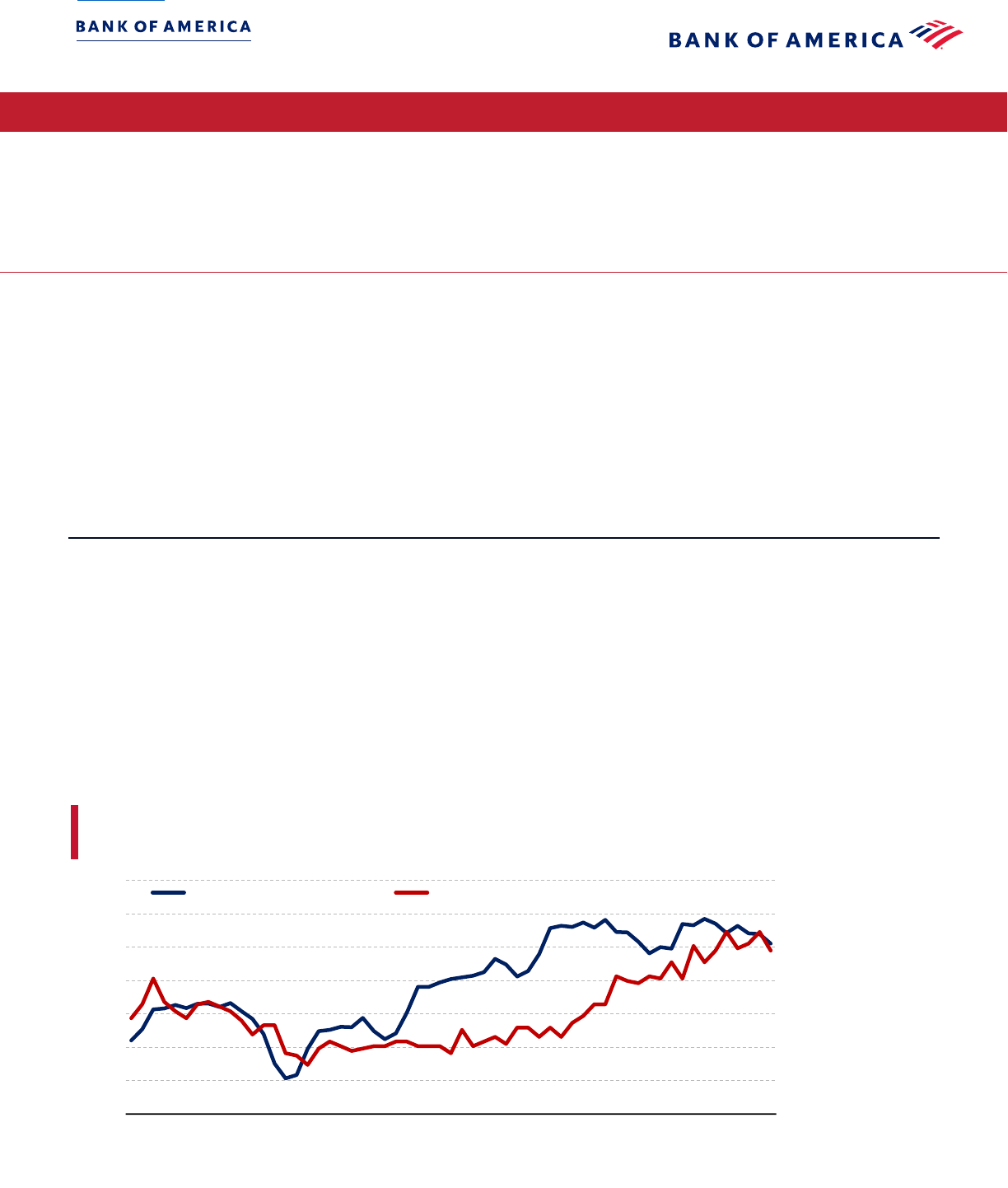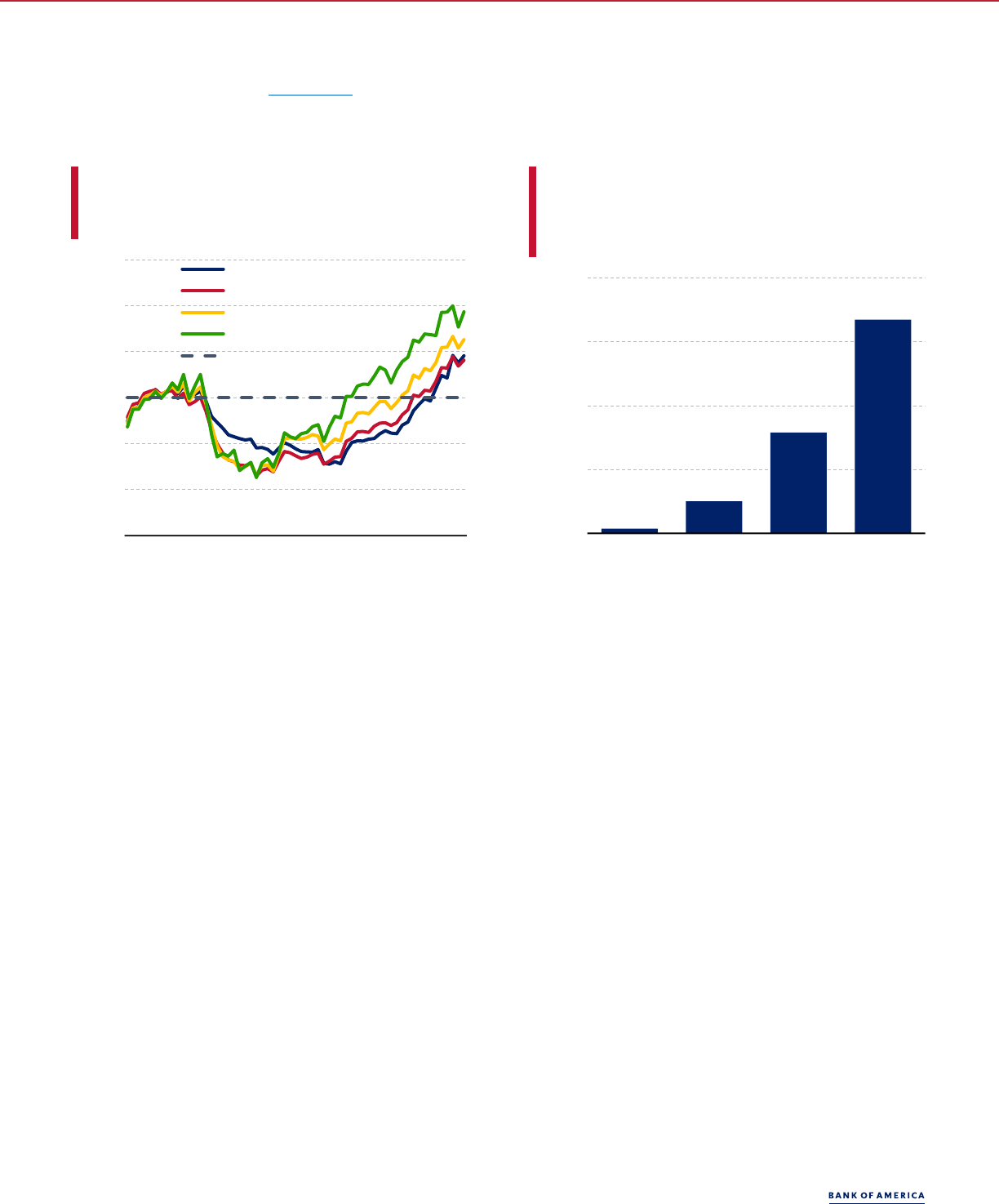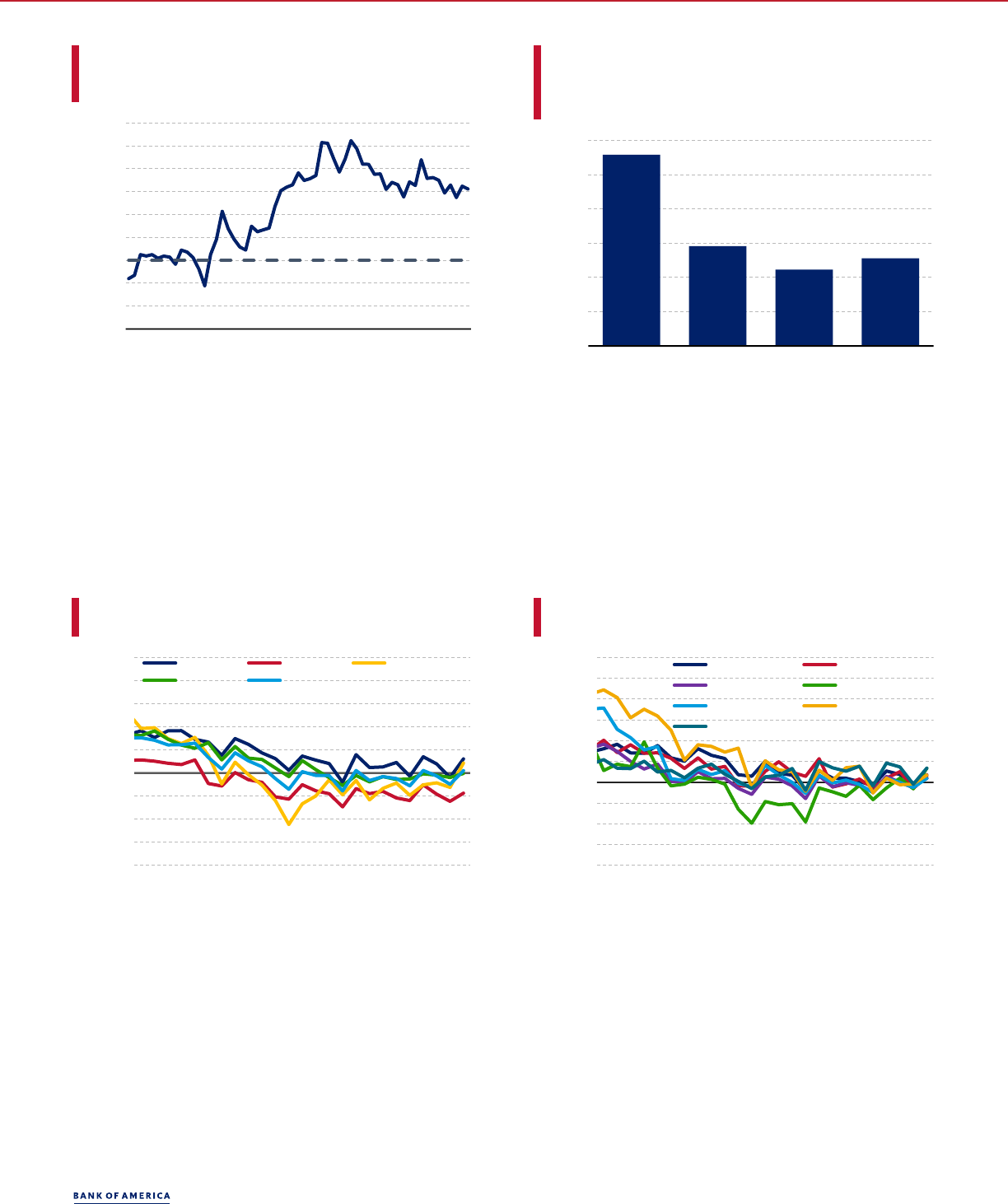
12659690
1
Small Business Checkpoint
Striking a balance on credit
15 February 2024
Key takeaways
• With small business demand for credit softening, rising outstanding loan balances might reflect some of the pressures small
businesses are under from tighter credit and higher interest rates. Additionally, Bank of America internal data suggests small
businesses are relying more on their credit cards.
• Positively, however, we find that 'inflation-adjusted' balances remain below pre-pandemic levels, even for small businesses with
annual revenue greater than $1 million, whose 2023 average balance increased by approximately 13% compared to the 2019
average.
• Plus, elevated deposit levels appear to be supporting small businesses across revenue tiers. Furthermore, total payments growth
per small business client rose year-over-year (YoY) in January, particularly in services sectors, a sign that small businesses
remain well-positioned.
Small Business Checkpoint is a regular publication from Bank of America Institute. It aims to provide a real-time assessment of small business spending
activities and financial well-being, leveraging the depth and breadth of Bank of America’s proprietary data. Such data is not intended to be reflective or
indicative of, and should not be relied upon as, the results of operations, financial condition or performance of Bank of America.
Outstanding loan balances might put pressure on credit card use
Recent surveys suggest that rising small business loan balances are increasing due to firms slowing repayments rather than
taking out new loans. The most recent Small Business Lending Survey from the Federal Reserve Bank of Kansas City showed
outstanding small business commercial and industrial (C&I) loan balances increased year-over-year (YoY) for the first time since
the first quarter of 2021, despite remaining stable in the last two quarters.
At the same time, the January 2024 Senior Loan Officer Opinion Survey found that banks continue to report a decrease in the
number of inquiries from potential small business borrowers seeking new or increased credit lines. Higher outstanding loan
balances, however, are likely to increase outlays for these firms, particularly as the actual interest rate paid on short-term loans
by borrowers has risen, according to National Federation of Independent Businesses (NFIB) respondents (Exhibit 1).
Exhibit 1: Though actual interest paid on short-term loans has increased according to NFIB data, credit card spending has remained relatively flat
Bank of America credit card spending per small business (SB) client (index, 2019 average = 100) and NFIB-reported actual interest rate paid on short-
term loan
by borrowers (%)
Source:
Bank of America internal data, NFIB
BANK OF AMERICA INSTITUTE
2
4
6
8
10
12
70
80
90
100
110
120
130
140
Mar-19 Oct-20 May-22 Dec-23
Small business credit card spending Actual interest rate paid on short-term loans by borrowers
I NSTITUTE
Accessible version

2
15 February 2024
I NSTI TUTE
So, is this a sign small firms are challenged by higher interest rates and tighter credit? Maybe. Bank of America aggregated and
anonymized small business credit card data signals small businesses are increasingly reliant on credit cards to finance their
operations. As we explained in November, credit card spending has been largely flat since halfway through 2023 (Exhibit 1
) and
has even recently started to decline on a per client basis, yet, credit card balances have continued to rise (Exhibit 2). This
suggests to us that more small businesses are using credit cards as source of financing this year with an increasing portion of
balances carrying interest after a decline in this revolving behavior during and post-pandemic.
Exhibit 2: Credit card balances have continued to rise across all
revenue tiers
Credit card balances per small business client by revenue tier (index,
2019 average = 100)
Source:
Bank of America internal data
BANK OF AMERICA INSTITUTE
Exhibit 3: Average credit card balances in 2023 have increased the
most since 2019 for those small businesses with annual revenue
greater than $1 million
Average credit card balances in 2023 by revenue tier (index = 2019
average, YoY4%)
Source:
Bank of America internal data
BANK OF AMERICA INSTITUTE
While some small businesses may be starting to feel financial pressure, two positive factors have emerged. First, the increase in
credit balances on Bank of America small business accounts since 2019 has been lower than the rise in the Consumer Price Index
(CPI) over the same period (around 19%). This is true across all revenue tiers. Accordingly, inflation-adjusted balances remain
below pre-pandemic levels, even for the largest small businesses (annual revenue greater than $1 million). The average balance
for these companies increased by approximately 13% in 2023 compared to the 2019 average (Exhibit 3).
Strong deposit levels offer support
Bank of America internal data also reveals positive signs when we consider the asset side of small business balance sheets.
Small businesses liquid assets in the form of deposit levels appear relatively strong, according to Bank of America internal data.
Exhibit 4 shows total deposit levels per small business client remain approximately 20% above the 2019 average. Across revenue
tiers, Bank of America internal data shows that small businesses with annual revenue of <$100K (microbusinesses) have seen a
rise in the ratio of deposits balances to credit card balances relative to January 2019 (Exhibit 5). These results show that
microbusinesses, which are more likely to rely on credit cards than small businesses with a greater annual revenue, appear to be
in relatively better financial shape.
70
80
90
100
110
120
130
Jan-19 Apr-20 Jul-21 Oct-22
Jan-
<$100k
$100k-$500k
$500k-$1M
>$1M
2019 average
0%
4%
8%
12%
16%
<$100k $100k-$500k $500k-$1M >$1M

15 February 2024
3
I NSTI TUTE
Exhibit 4: Deposit levels remain elevated compared to the 2019
average
Deposit levels per small business client (indexed, 2019 average = 100)
Source:
Bank of America internal data
BANK OF AMERICA INSTITUTE
Exhibit 5: The ratio of deposits to credit card balances relative to
2019 has increased for microbusinesses
Ratio of credit card balances to deposit levels per small business client
in January 2024 (indexed, January 2019 = 100)
Source:
Bank of America internal data
BANK OF AMERICA INSTITUTE
Monthly payments update
Looking more broadly at small business activities in January, we find total payments per small business client were up 1.0% YoY
(Exhibit 6). Among the major components, ACH jumped 6.1% YoY in January. Conversely, the largest decrease %YoY was
payments by check.
Across sectors, payments growth turned positive across the board in January (Exhibit 7). Most notably, Finance increased 6.7%
YoY, after a decline of 3.2% YoY in December. Health Services and leisure-related businesses like Restaurants and Lodging were
also fairly strong.
Exhibit 6: Across all select channels, payments growth increased
Payments per small business client by select channels (%YoY)
Source:
Bank of America internal data
BANK OF AMERICA INSTITUTE
Exhibit 7: Across all select sectors, payments growth increased
Payments per small business client by select sectors (%YoY)
Source:
Bank of America internal data
BANK OF AMERICA INSTITUTE
Methodology
Selected Bank of America transaction data is used to inform the macroeconomic views expressed in this report and should be
considered in the context of other economic indicators and publicly available information. In certain instances, the data may
provide directional and/or predictive value. The data used is not comprehensive; it is based on aggregated and anonymized
selections of Bank of America data and may reflect a degree of selection bias and limitations on the data available.
85
90
95
100
105
110
115
120
125
130
Mar-19 Oct-20 May-22
Dec-2
80
85
90
95
100
105
110
<$100k $100k-$500k $500k-$1M $1M+
-40%
-30%
-20%
-10%
0%
10%
20%
30%
40%
50%
Jan-22 May-22 Sep-22 Jan-23 May-23 Sep-23
Jan-2
ACH Check Wires
Total Card Total
-40%
-30%
-20%
-10%
0%
10%
20%
30%
40%
50%
60%
Jan-22 Jul-22 Jan-23 Jul-23
Jan-2
Construction Manufacturing
Retail Finance
Restaurants Lodging
Health Services

4
15 February 2024
I NSTI TUTE
Any Small Business payments data represents aggregate spend from Small Business clients with a deposit account or a Small
Business credit card. Payroll payments data include channels such as ACH (automated clearing house), bill pay, checks and wire.
Bank of America per Small Business client data represents activity spending from active Small Business clients with a deposit
account or a Small Business credit card and at least one transaction in each month. Small businesses in this report include
business clients within Bank of America and are generally defined as under $5mm in annual sales revenue.
Unless otherwise stated, data is not adjusted for seasonality, processing days or portfolio changes, and may be subject to
periodic revisions.
Revenue tiers are determined by the combination of following factors: 1) stated revenue on small businesses credit or PPP
applications, 2) actual account inflow into BofA Deposit Accounts, and 3) third party revenue estimation.
Data regarding merchants who receive payments are identified and classified by the Merchant Categorization Code (MCC)
defined by financial services companies. The data are mapped using proprietary methods from the MCCs to the North American
Industry Classification System (NAICS), which is also used by the Census Bureau, in order to classify spending data by subsector.
Spending data may also be classified by other proprietary methods not using MCCs.
Additional information about the methodology used to aggregate the data is available upon request.
Contributors
Taylor Bowley
Economist, Bank of America Institute
David Michael Tinsley
Senior Economist, Bank of America Institute
Sources
Patrick Williams
Senior Vice President, Digital Marketing
Josh Long
Consumer Product Strategy Manager, Consumer and Small Business
Kevin Burdette
Consumer Product Strategy Analyst, Consumer and Small Business
Michael Lutz
Strategy Executive, Small Business, Specialty Lending & Banking

15 February 2024
5
I NSTI TUTE
Disclosures
These materials have been prepared by Bank of America Institute and are provided to you for general information purposes only. To the extent these materials reference Bank of
America data, such materials are not intended to be reflective or indicative of, and should not be relied upon as, the results of operations, financial conditions or performance of Bank
of America. Bank of America Institute is a think tank dedicated to uncovering powerful insights that move business and society forward. Drawing on data and resources from across
the bank and the world, the Institute delivers important, original perspectives on the economy, sustainability and global transformation. Unless otherwise specifically stated, any
views or opinions expressed herein are solely those of Bank of America Institute and any individual authors listed, and are not the product of the BofA Global Research department or
any other department of Bank of America Corporation or its affiliates and/or subsidiaries (collectively Bank of America). The views in these materials may differ from the views and
opinions expressed by the BofA Global Research department or other departments or divisions of Bank of America. Information has been obtained from sources believed to be
reliable, but Bank of America does not warrant its completeness or accuracy. Views and estimates constitute our judgment as of the date of these materials and are subject to change
without notice. The views expressed herein should not be construed as individual investment advice for any particular person and are not intended as recommendations of particular
securities, financial instruments, strategies or banking services for a particular person. This material does not constitute an offer or an invitation by or on behalf of Bank of America to
any person to buy or sell any security or financial instrument or engage in any banking service. Nothing in these materials constitutes investment, legal, accounting or tax advice.
Copyright 2024 Bank of America Corporation. All rights reserved.
